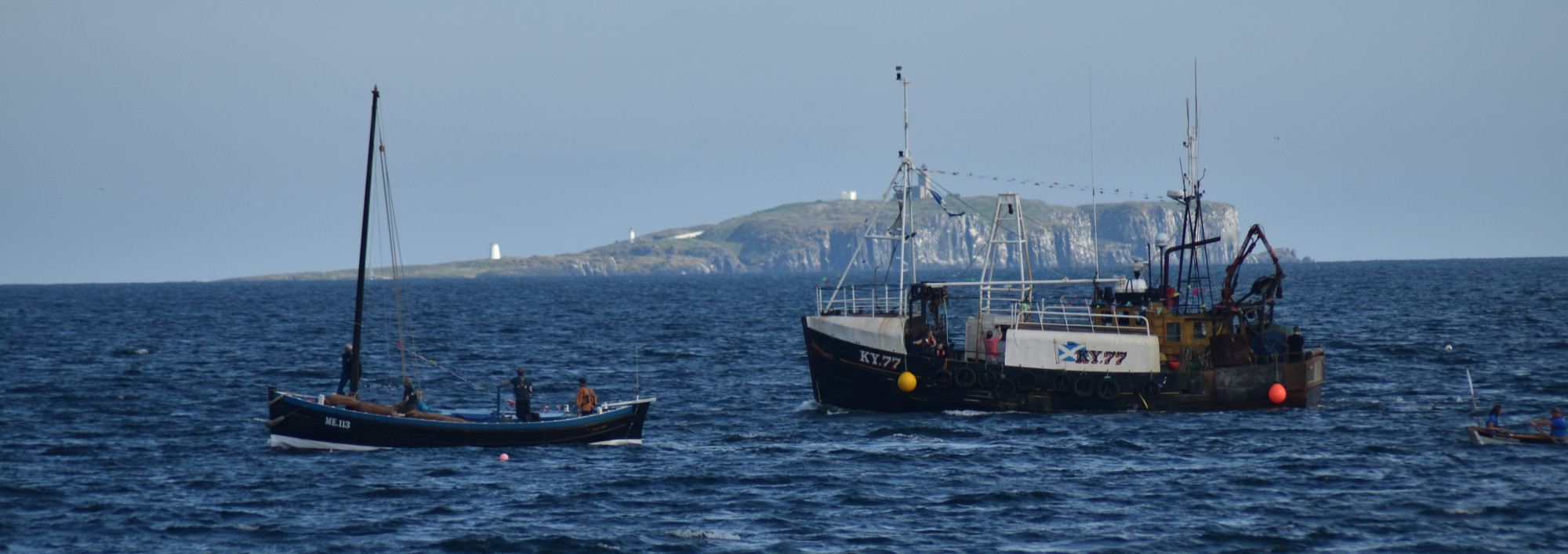Deck and superstructure on in November 2019
The vessel was craned out in Bromborough in November 2019. These photographs show the deck structures, some of which were then removed for transportation by road.
At the bow a large steel tripod used as a derrick

On the foredeck were a large bollard, a skylight for the cabin and the companion hatch to starboard. The deck has been covered with fibreglass.

Foredeck bollard 
Cabin skylight 
Companion hatch
Further aft were the hold hatch and a winch.

Hold hatch 
Winch
Aft of the winch was an aluminium wheelhouse
Aft of the wheelhouse was a mizzen mast.

Measuring the hull

After transfer to Fife in February 2020, the hull was measured externally using a template and laser measure, with the line of the keel as baseline.
The data was inputted into DelftShip CAD software and the baseline was corrected to the waterline rather than the keel, as the original lines plans would have been.

The following dimensions were obtained:
- Length overall 14.9m (49’)
- Length on waterline 14.0m (46’)
- Beam 4.8m (15.75’)
- Draft 1.6m (5.25’)
- Estimated displacement 28.3 tonnes
- The boat has a steep stem and a cruiser stern.
- Minimum freeboard is 1.22m from waterline to rail
- The deck is located 300 mm (12”) below the rail in the stern and midships, with a step up to 140mm below the rail at the forecastle.
- There is a large rubbing strake located just below deck line and a small rubbing strake xxmm below this.
- There is a small bilge keel, consisting of a thickened hull plank, at the turn of the bilge.
- There is a 4 blade clockwise propellor measuring 660mm diameter.
- There is a balanced rudder with its heel pintle located in the skeg

Interior of the hull
The interior has been looked at in more detail in July 2020:
- The keel, stem and boss post (sternpost) are oak. The keel and boss post (sternpost) are 6” (150mm) and the outrigger (counter horn) and stem 5” (125mm) thick. There is a steel shoe on the keel.
- There are 36 transverse frames made of sawn oak 3” (75mm) thick and 5” (125mm ) depth at 14” (360mm) intervals. There are 3 radial cant frames on each side in the stern.
- The hull planking is 1.25” (33mm) thick and is reported to be Oregon pine
- The deck planking is 1.5” – 2” thick pine
- There is poured concrete in the bilges for ballast.
- There is a cabin forward extending from frame 1 to frame 15, accessed by a companion hatch on the starboard side of the deck.
- The hold extends from frame 15 to Frame 23, accessed by a midline hold hatch, located between frame 20 and frame 23.
- The engine room extends from frame 23 to frame 35.
- There is a Gardner 6cyl diesel engine. The engine is located between frame 24 and frame 30.
- There are fuel tanks on both sides extending from frame 27 to frame 31, the port tank no longer functions, having been cut open for use as a store.

Gardner 6cyl engine 
engine 
Fuel tank to starboard 
Starboard cant frames and bilge stringer at the stern 
Frames and bilge stringer showing concrete ballast
Aft of the engine room is the steering gear with chains, quadrant and rudder stock

Steering chain below aft deck 
Quadrant and rudder stock
Cabin Details
The cabin is located for’ard. There are 4 berths in the forepeak, 2 on each side, upper and lower. Aft of the berths there is a locker on either side. There is a bench on the port side, extending aft from the forepeak. Aft of the locker is a large seat/aft lower berth and an upper berth on each side. There is a table in the for’ard part of the cabin.

Cabin for’ard 
Cabin aft port 
…and starboard
Aft of the port side seat/aft lower berth is a bulkhead separating the galley which consists of a sink and drainer on the port side with lockers above and below, and a work surface and reflective tiles on the aft bulkhead of the cabin at frame 15. To starboard, aft of the starboard large seat/aft lower berth is the companion ladder and to starboard of this, extending aft, is storage/hanging space extending to frame 18.

Galley sink to port 
Galley work surface 
Store and hanging locker to starboard
The cabin furniture is mainly made of varnished tongue-and-groove, with the lower parts painted yellow. The ceiling on the interior surface of the hull in the cabin is tongue-and-groove, much of which is in a poor state of repair.

The undersurface of the cabin deck beams are lined with tongue-and-groove. There is a skylight in the deck midline above the cabin.
Condition of the Hull and Deck
Full assessment of the state of the hull and deck will not be possible until the internal structures have been removed sufficiently to expose the hull woodwork. The following observations are based on an initial visual assessment
Below the waterline, the hull planking is substantially intact. Some of the planks have sprung out at their ends where the fastenings have failed. There are visible gaps between many of the planks due to shrinkage as a result of dehydration. This is to be expected. There are some cracks and fissures in the planks where mussels had taken up residence!

Above the water line there is evidence of rot in the planks, and particularly in the large rubbing strake just below deck height. There is also rot in the bulwarks and gunwales.

Much of the centreline structures (keel ,hog, deadwoods, stern post, stem and apron) cannot be assessed yet. Some checking (fissuring) is visible in the stern post (boss post) around the propeller shaft. There appears to be rot in the upper part of the stem.
There is evidence of rot in some frames, both in the bilges, where the frames enter the concrete ballast, and in the top sections, above and below the sheer line, especially amidships.

The beam shelf has not yet been assessed. The deck beams are mainly wood, with a small number of L-section steel beams. There is evidence of reversal of deck camber especially towards the stern, indicating loss of shape of the deck beams. The deck has been mainly covered with a layer of fibreglass. There is widespread degradation of the deck planking, due to rot and mechanical damage.










